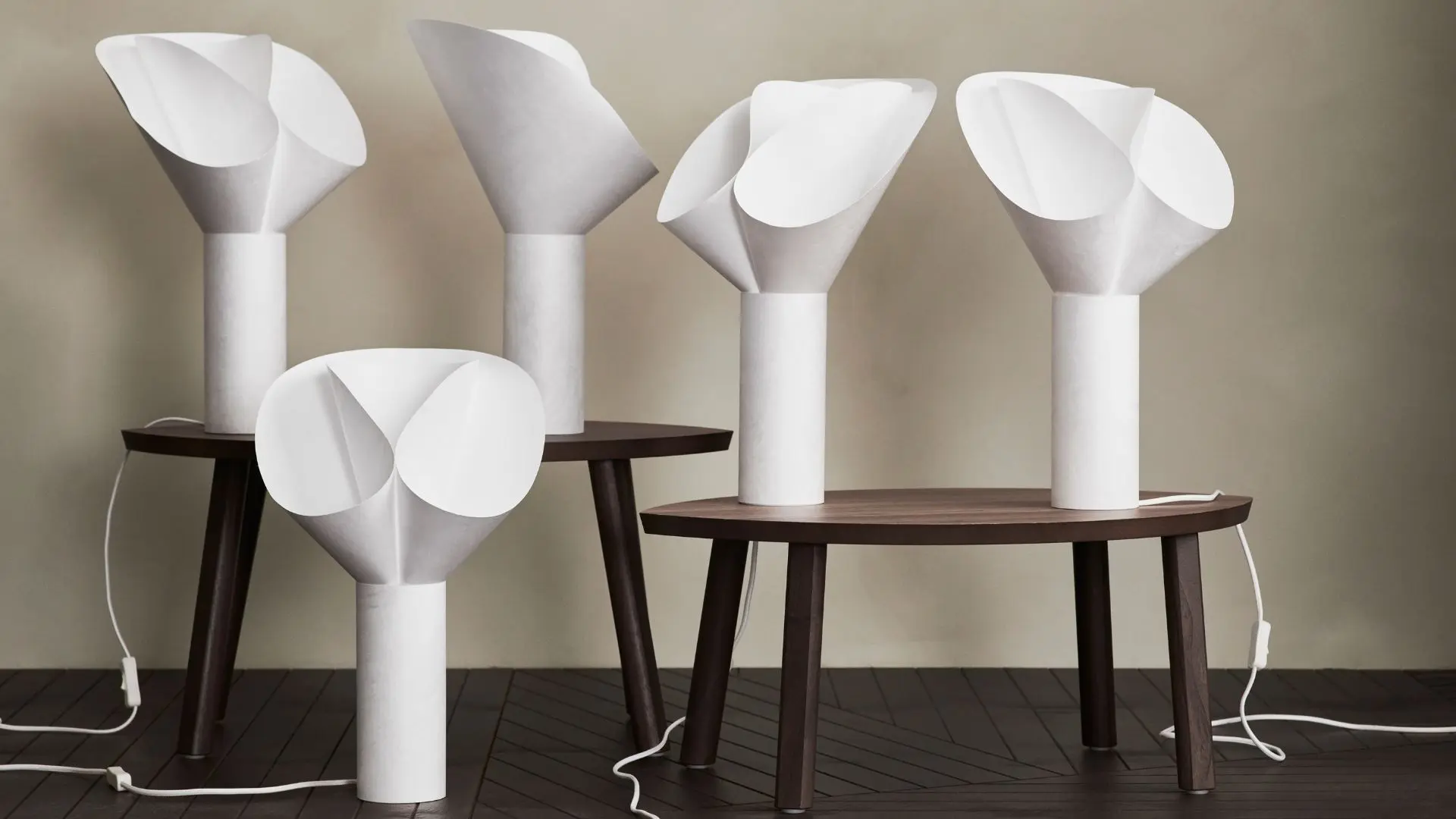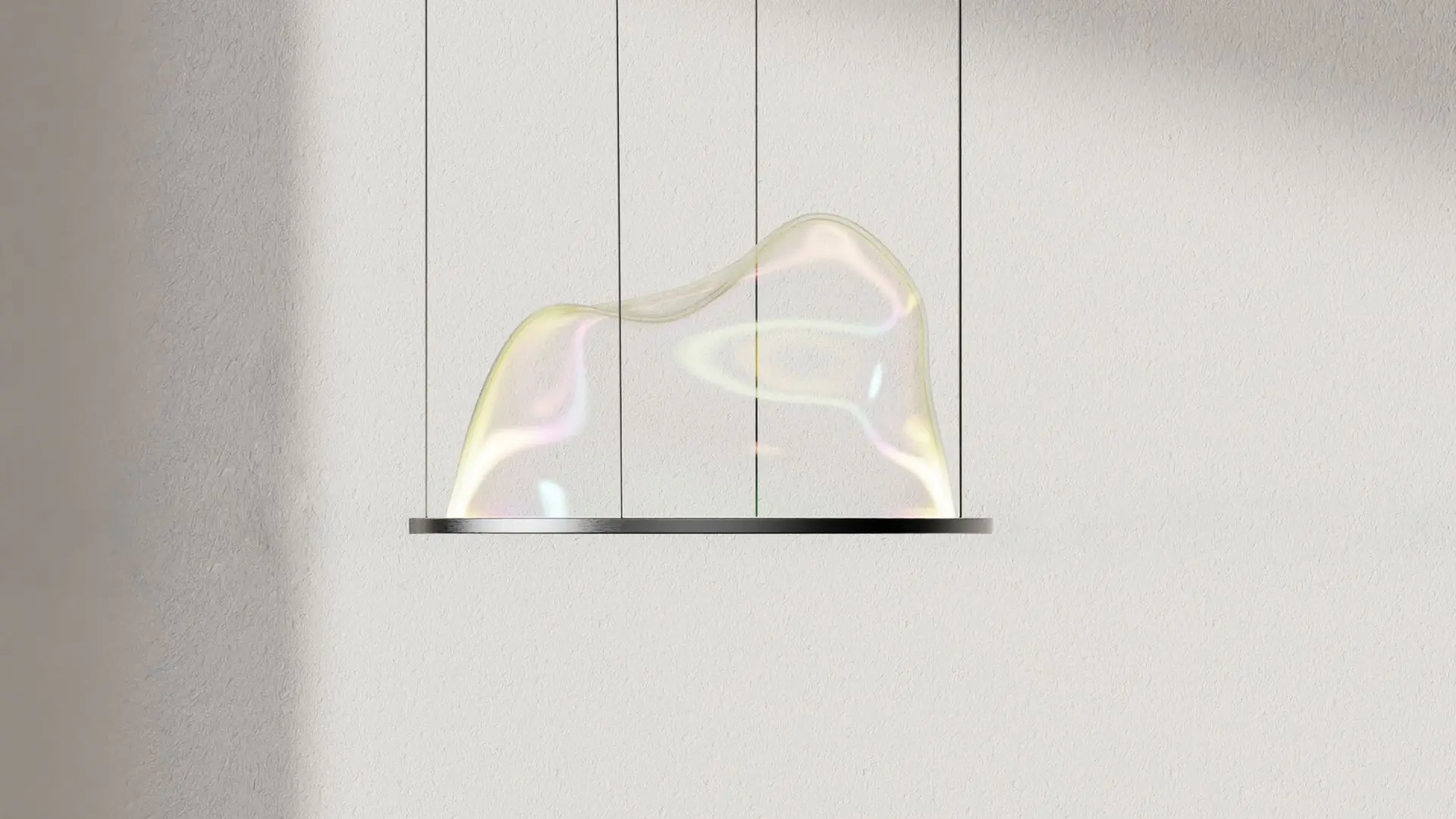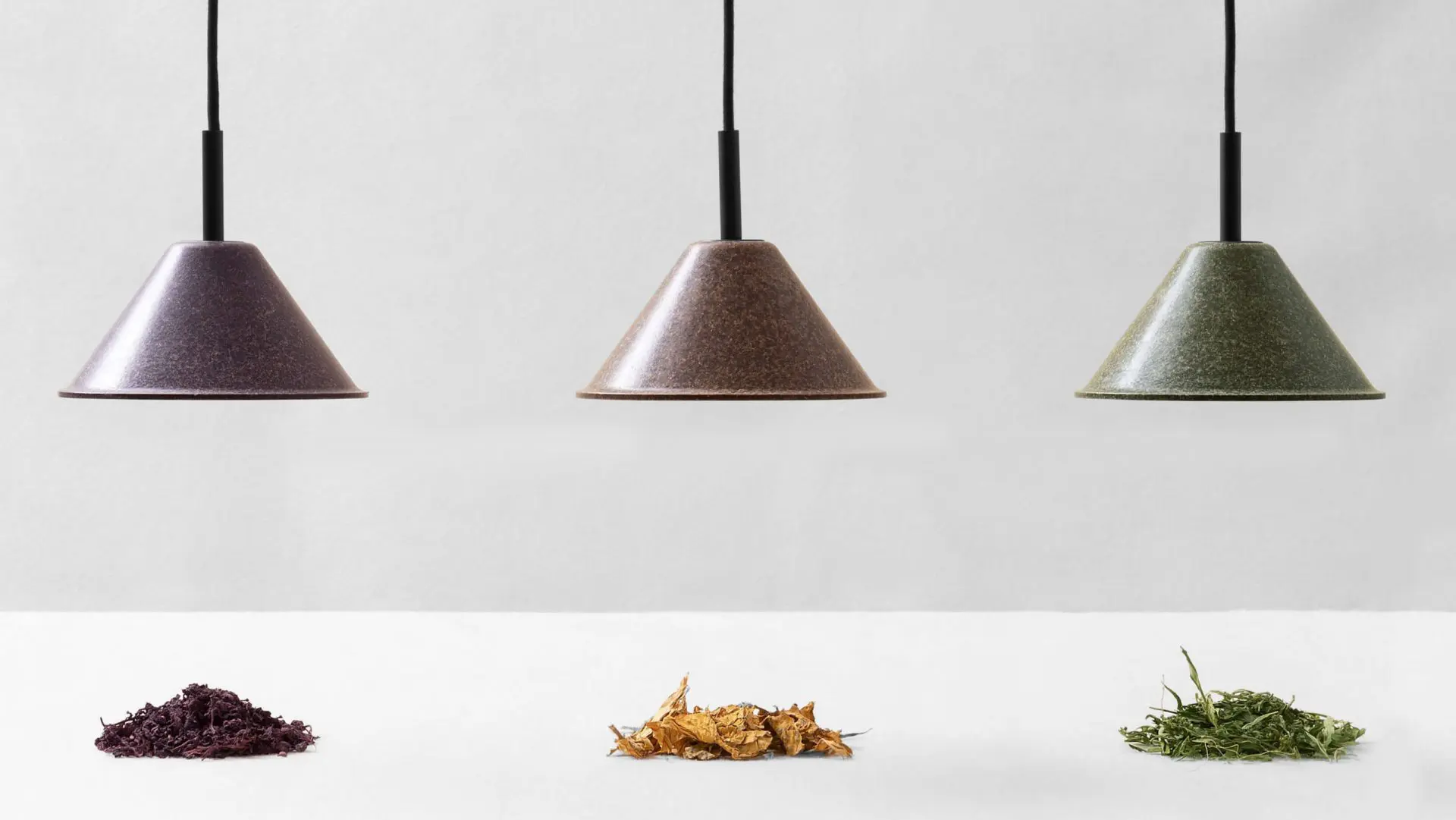What does it mean to design for the world’s most democratic design powerhouse?
In this exclusive interview, we explore the collaboration behind BÄCKNATE, a sculptural yet accessible lamp co-created by Raffaella Mangiarotti, founder of her Milan-based namesake design studio, and Chiara Ripalti, Product Developer at IKEA.

Launched in January 2025, BÄCKNATE is a new collection of table and pendant lamps by IKEA. Crafted from Tyvek — a recyclable, lightweight, and paper-like material — the lamps are shaped through a process of folding and sculpting, resulting in a soft, ambient glow.
BÄCKNATE is the product of a thoughtful collaboration between Raffaella Mangiarotti, a Milan-based designer celebrated for her elegant, sustainability-driven vision, and Chiara Ripalti, a veteran Product Developer at IKEA with extensive expertise in lighting design and product development. This pairing brings together two complementary perspectives: Mangiarotti’s background in architecture and environmental design — recognized internationally and featured in institutions like MoMA — and Ripalti’s deep, hands-on experience in navigating IKEA’s internal development ecosystem.

Their combined efforts result in a lamp that reflects IKEA’s democratic design values and Mangiarotti’s refined aesthetic sensitivity — a minimalist yet expressive object that embodies the challenges and beauty of designing responsibly for the everyday home.
It was a true pleasure to explore their shared experience and gain deeper insight into how the project came to life — and, equally, to better understand the inner workings of IKEA’s product development process, designed to uphold the company’s core values at every stage.
How did the idea behind BÄCKNATE originate? What inspired you?
Raffaella Mangiarotti:
“The idea came from a simple gesture: folding a sheet. I was exploring how form could emerge from the inner tension of the material — from a fold that becomes structure. IKEA had asked for an expressive lamp, almost like an art object, capable of speaking through light. I tried to respond with lightness — not only physical, but conceptual. I feel at ease in this essential approach. I like not to waste, to get the most out of very little. I’m drawn to a certain idea of design, and I feel moved by the work of those designers – past and present – who believe in honest, democratic objects, designed for everyone yet never banal.”
The lamp features a minimal aesthetic yet makes a strong visual impact – how did you balance those elements?
Raffaella Mangiarotti:
“BÄCKNATE is made of very little: two discs and two folded sheets in the table version, three sheets and a socket in the pendant one. Yet every part has a precise function, and together they create a simple but decorative sign. I believe the decorative aspect comes from the form itself: it is shaped by the tension within the sheet, so while it’s essentially flat, it becomes soft and sensual in volume. The material also contributes to its precious feelings. Light filters through it, revealing its fibers, like Japanese washi paper. It looks like ancient material, but it’s highly technological.”

Chiara Ripalti:
“Creating an affordable product is always the result of a close collaboration, a careful balancing act between all the elements that make up the final design, from production to the everyday lives of people who will use it. The development process is rarely linear; it involves constant testing, adjusting, and refining until everything aligns. At IKEA, we call this democratic design, where form is just one part of the bigger picture. And even when the shape is bold and expressive, like BÄCKNATE, every detail is precisely calibrated by us to meet that vision.”
What were the main design challenges during the development of BÄCKNATE?
Raffaella Mangiarotti:
“What looks minimal is often the result of deep thinking and subtraction. As Vico Magistretti said, simplicity is the most complicated thing in the world. It’s the outcome of an analytical process, where you remove everything non-essential or non-expressive. With IKEA, this becomes even more crucial: it’s a product that must be affordable. So, you need to carefully choose the right material, use as little of it as possible, and give it the most expressive, valuable form. You must know what to eliminate – even a single screw, a single extra part, adds cost.
With IKEA’s volumes, every small element affects the overall budget significantly. We spent a long time studying how to arrange the flat parts, to use as little space as possible. That’s key to transport costs, and it often leads to tough decisions that directly shape the design. You need to be more inventive, because the constraints are tighter. Sometimes, entire days go into reducing the packaging by just one centimeter – but multiplied by millions of units, that centimeter matters. It’s a meaningful exercise: it makes you think deeply about how not to waste, how to respect resources.”

Chiara Ripalti:
“Our goal was to use paper-like material that would last longer than regular paper while being resilient to various environments, such as different humidity levels, an important consideration for global selling. The material we selected allowed us to extend the product’s lifespan significantly beyond that of traditional paper, making it easier to maintain. We meticulously calibrated and chose the right thickness to preserve the shape while showcasing the fibers, typical of this material. The flat packaging was also crucial; we carefully designed the components to ensure the product remained as flat as possible yet easy to assemble.”
What was it like working with IKEA? How does this collaboration differ from your experiences with other brands?
Raffaella Mangiarotti:
“IKEA has a strong design culture. It develops many projects internally, but it also opens dialogue with well-established external designers. Over the years, they’ve worked with names like Virgil Abloh, Tom Dixon, Hella Jongerius, Ilse Crawford, Sabine Marcelis. At the IKEA Museum, I even found a lamp by Vico Magistretti, designed and sold in the 1970s. Being part of this network and bringing my own design language into such a vast context has been deeply rewarding.
Compared to other experiences, scale changes everything. Every choice has major industrial and environmental consequences. An idea can’t just be beautiful – it must be essential and justified. Another unique aspect is the global diffusion of the product. It’s moving to see images of your lamp in homes all over the world, to receive messages, videos, and beautifully styled photos from people who are proud to have it. It reminded me of the emotional impact of the products I designed for SMEG (with M. Bazzicalupo) – widely distributed and warmly received.”

How did IKEA’s design philosophy influence the final outcome?
Raffaella Mangiarotti:
“IKEA has very clear values: simple, linear forms with a typically Scandinavian character; every product must meet practical, everyday needs; durability and resistance tests that are often stricter than official regulations; and very accessible pricing. A very democratic object. You already know, in a way, the kind of product you’re expected to design – certainly not a marble and brass coffee table. This is also liberating: it brings you back to the roots of design, when you had to be both democratic and original, without relying on luxurious materials to define quality. It’s harder to make something beautiful without precious materials. Reducing waste, simplifying processes, using fewer resources – these are requirements that force you to design with precision, without superfluous flourishes. But this mindset aligns with mine: respect for materials, for the people who produce the object, and for those who will use it.
Where does BÄCKNATE sit within IKEA’s broader lighting range?
Raffaella Mangiarotti:
“The brief asked for a lamp that would be more of a poetic gesture than a purely functional object. So BÄCKNATE fits more into the decorative category. I see it as a quiet, atmospheric presence. In a broad and rational collection like IKEA’s, BÄCKNATE introduces a softer rhythm. The brief asked for a lamp that would be more of a poetic gesture than a purely functional object. So BÄCKNATE fits more into the decorative category. I see it as a quiet, atmospheric presence. In a broad and rational collection like IKEA’s, BÄCKNATE introduces a softer rhythm.”

Chiara Ripalti:
“BÄCKNATE is a design that looks like a sculpture when turned off and comes to life when lit up. It’s aimed at sophisticated customers who carefully select their home décor. This is clear from the people who bought these lamps today. The light it provides is gentle and decorative, perfectly matching the shape and materials of the lamp.”
What role does sustainability play when designing for a company like IKEA?
Raffaella Mangiarotti:
“Sustainability wasn’t an added value – it was the starting point. We worked on the material’s 100% recyclability, the possibility of disassembling the lamp and returning it to a flat sheet, minimizing the number of components, on flat packing and lightweight construction. We collaborated with a highly specialized, structured team – material experts, logistics, engineering – all working together to reduce environmental impact, transport costs, and waste. But for me, sustainability is also a question of ethics. Lightness isn’t just about weight — it’s visual and cultural. Designing with respect: to materials, for time, for people.”
Chiara Ripalti:
“Sustainability is a key element of our democratic design approach. We carefully consider it at every stage of product development and ensure it is never compromised. It’s not just about choosing sustainable materials; it’s about making products that last longer and are easy to care for. For example, using paper for BÄCKNATE’s shade would have been less sustainable because paper can break easily, reducing the product’s lifespan and creating waste from durable components, like the corset of the lamp. Sustainability also means creating a connection with what people buy, giving it value. With BÄCKNATE, the choice of Tyvek instead of plain plastic adds warmth and a natural look, making people more likely to care for and love the product. So, sustainability is also about creating a feeling or connection that makes people care for their belongings. This bond helps products last longer and can lead to them being passed on for second-hand use.”

What makes a product “universal” in IKEA’s language, in your opinion?
Raffaella Mangiarotti:
“A universal product isn’t anonymous or generic. It’s open. It works across contexts because it leaves room for interpretation. It doesn’t impose a use – it suggests one. I believe it must carry a sense of empathy, a direct way of speaking. It has to resonate across cultures. And to do so, it must reach not only reason, but emotion. Because a product can be correct, functional, well-designed – but if it doesn’t touch something deeper, it doesn’t seduce.”











